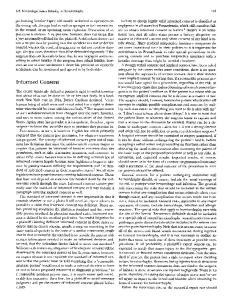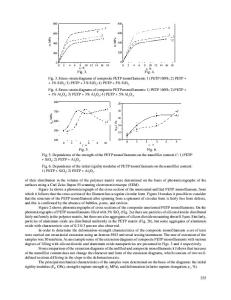Relating Nanostructures to Mechanical Properties in Ion-Implanted Materials
- PDF / 1,282,544 Bytes
- 13 Pages / 612 x 792 pts (letter) Page_size
- 103 Downloads / 332 Views
Relating Nanostructures to Mechanical Properties in Ion-Implanted Materials David M. Follstaedt, James A. Knapp, Samuel M. Myers and Gary A. Petersen Sandia National Laboratories, Albuquerque, NM 87185-1056 ABSTRACT Ion implantation was used to form high densities (~1019 /cm3) of small oxide precipitates in Ni in order to investigate the strength mechanism produced by such highly refined structures. Nanometer-size precipitates of Al2O3 and NiO are found to block dislocation motion in the Ni matrix, producing yield strengths up to 4.6 GPa, more than twice that of hardened bearing steel. Dispersion strengthening theory, developed for micrometer-size precipitates and spacings, was found to account quantitatively for the yield strengths produced by nanometer-size oxides as well. Nanoindentation plus finite-element modeling was used to quantify the mechanical properties of implanted metal layers, and was extended to examination of amorphous Si layers formed by self-ion implantation. The amorphous phase was found to have a yield strength of 4.45 + 0.20 GPa, Young’s modulus of 144 + 7 GPa, and hardness of 10.3 + 0.4 GPa. The modulus and hardness are reduced by 10% and 15%, respectively, from those of crystalline Si. INTRODUCTION Developing materials with greatly improved mechanical properties requires investigating new microstructural regimes. The properties often exhibit scaling behaviors that can guide microstructure manipulation to achieve improvements. For examples, the strength of two-phase alloys increases with increasing density of smaller precipitates [1], and the hardness and strength of metals increase as grain sizes are reduced [2,3]. In addition, metastable structures like amorphous phases can have properties different from those of stable phases. Synthesizing well defined microstructures and evaluating their mechanical properties quantitatively are needed to identify the basic principles determining the resulting properties. Another method for achieving improved properties is with layered composites of different materials [4]. Thus, the abilities to produce layers with tailored nanometer-size structures (“nanostructures”) and to quantify the mechanical properties of layers are important. Mechanical properties at surfaces are important because they govern the tribological performance and lifetime of numerous engineering components in moving contact. These properties can be improved by modification of the near-surface region as well as by deposition of adherent layers. In addition to conventional systems, new types of miniature devices are being developed: Micro-ElectroMechanical Systems (MEMS). Their small sizes hold great promise for numerous applications. In a class of MEMS termed Surface Micromachines, the deposition methods of microelectronics fabrication are used to produce Si devices with micrometer-scale components [5]. In a second class, sub-millimeter metallic components, often Ni or Cu, are electroformed into high-precision molds [6]. With the higher surface-to-volume ratio of such small parts, surfac
Data Loading...










